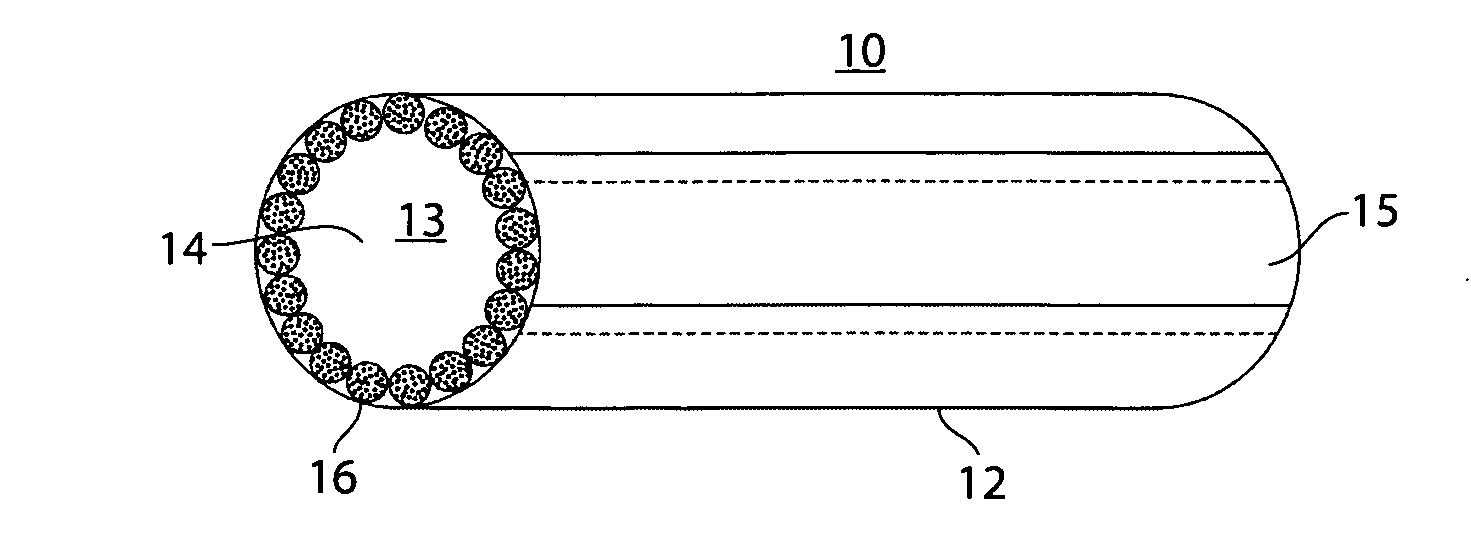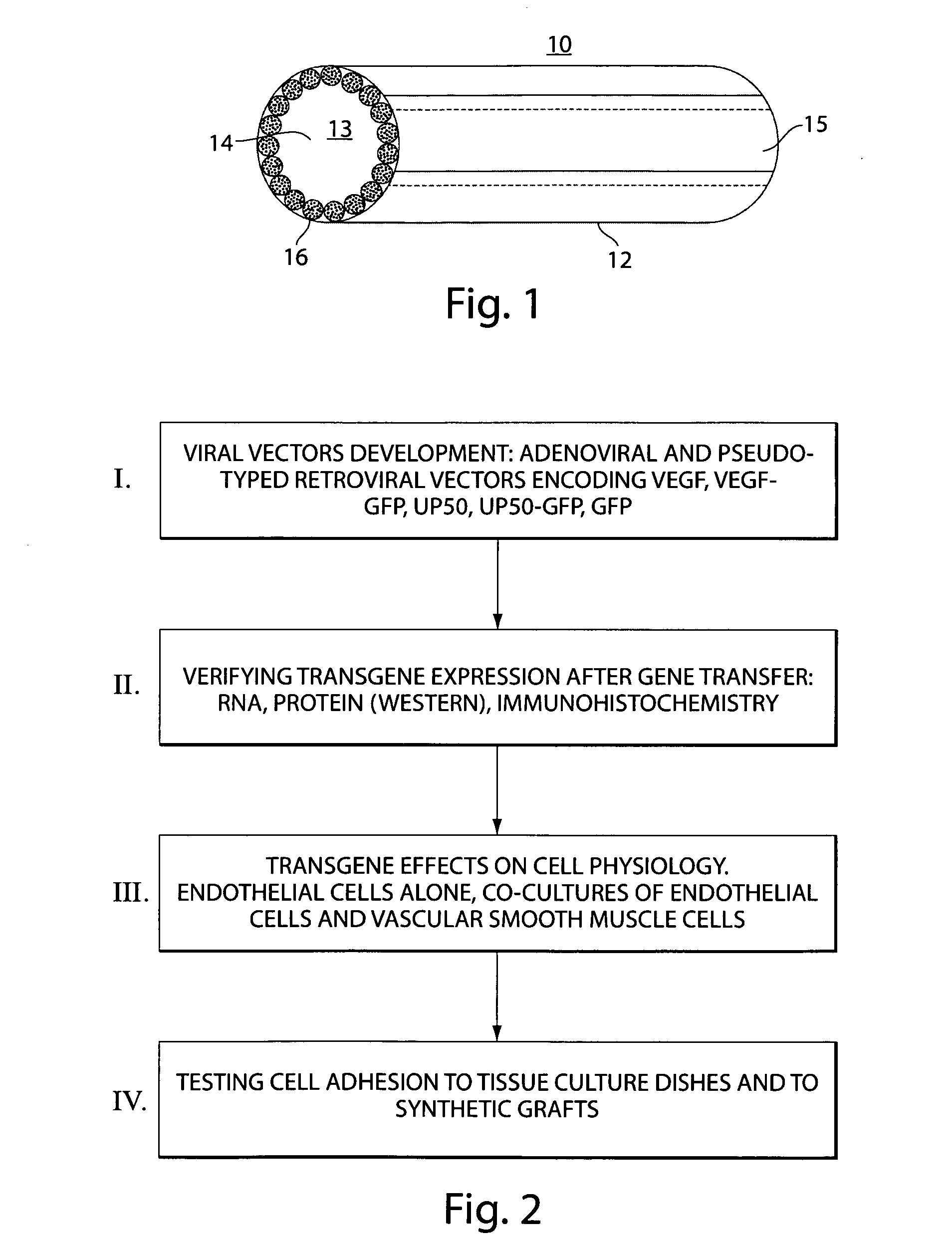Nucleic acid constructs encoding cell growth and adhesion factors and cells expressing them
a technology of adhesion factor and nuclear acid, which is applied in the field of nucleic acid constructs encoding cell growth and adhesion factor and cells expressing them, can solve the problems of graft failure, higher failure rate, and closure of gra
- Summary
- Abstract
- Description
- Claims
- Application Information
AI Technical Summary
Benefits of technology
Problems solved by technology
Method used
Image
Examples
example 1
Generation of Recombinant Adenoviral Vectors Encoding the LacZ Gene
[0144]A 3700 bp HindIII-BamHI fragment containing the bacterial β-galactosidase gene LacZ (Clontech, CA, USA) was inserted into plasmid pCA3 for constitutive expression under the control of the CMV immediate-early promoter. The resultant plasmid was co-transfected with plasmid pJM17 into “293” cells that constitutively express the adenoviral E1 gene. Plasmid pJM17 contains the adenovirus genome, excluding the E3 region, and including an insert (pBRX) in the E1 region of the virus. Homologous recombination between pCA3 encoding β-galactosidase and pJM17 following transfection replaced the E1 region of pJM17 with the CMV-β-galactosidase expression cassette from pCA3. Plaque formation occurred 2 to 4 weeks following co-transfection, after which individual plaques were isolated and viral extracts were amplified therefrom by infection of “293” cells. The titer of each viral stock was determined by plaque assay in “293” ce...
example 2
Generation of Recombinant Bicistronic Adenoviral Vectors Encoding the VEGF and GFP Genes
[0145]A 600 bp BamHI fragment containing the human VEGF165 cDNA (Genbank Accession number AB021221), including the signal sequence for secretion (gift of Dr. J. Abraham, Scios Nova, Mountain View, Calif.) was inserted into the BglII site of shuttle vector pQBI-CMV5-GFP (QBI, Canada), thereby generating shuttle vector CMV5-VEGF165-IRES-EGFP (FIG. 3a). The expression plasmid pQBI-CMV5-GFP contains the left arm (16%) of the Ad5 genome with a deletion in the E1 region containing a hCMV5 insert. Shuttle vector CMV5-VEGF165-1RES-EGFP was co-transfected with plasmid pJM17 into “293” cells constitutively expressing the E1 gene. The pJM17 plasmid contains the adenovirus genome, excluding the E3 region, and including an insert (pBRX) in the E1 region of the virus. Homologous recombination between CMV5-IRESVEGF165-GFP and pJM17 following transfection replaced the E1 region and pBRX insert with the expressio...
example 3
Generation of Pseudotyped Retroviral Vectors Encoding Human VEGF and GFP
[0146]Recombinant retroviral vectors encoding the GFP and human VEGF165 genes were constructed by cloning into plasmid pLXSN (#K1060-B Clontech, USA) in two steps. First, a 600 bp BamH1 fragment encoding VEGF165 (Genbank Accession number AB021221) was inserted into the BamH1 site of plasmid pIRES2-EGFP (#6029-1 Clontech). Then, a 2.0 kB EcoR1-Mun1 fragment containing the VEGF165, IRES and EGFP encoding sequences was cloned into the EcoR1 restriction site in pLXSN resulting in vector LXSN-VEGF165-IRES-EGFP (FIG. 3b). For retroviral vector production, 293E3 ecotropic packaging cells were transiently transfected with LXSN-VEGF165-EGFP. After 48 hours, the supernatant from confluent cultures of G418-resistant producer cells was collected, filtered (0.45 μm) and used to transduce PA317 amphotropic packaging cells. Transduced PA317 cells were grown under G418 (Gibco, BRL USA) selection (300 mg / ml) and after 48 hours t...
PUM
| Property | Measurement | Unit |
|---|---|---|
| area | aaaaa | aaaaa |
| time | aaaaa | aaaaa |
| temperature | aaaaa | aaaaa |
Abstract
Description
Claims
Application Information
 Login to View More
Login to View More - R&D
- Intellectual Property
- Life Sciences
- Materials
- Tech Scout
- Unparalleled Data Quality
- Higher Quality Content
- 60% Fewer Hallucinations
Browse by: Latest US Patents, China's latest patents, Technical Efficacy Thesaurus, Application Domain, Technology Topic, Popular Technical Reports.
© 2025 PatSnap. All rights reserved.Legal|Privacy policy|Modern Slavery Act Transparency Statement|Sitemap|About US| Contact US: help@patsnap.com



